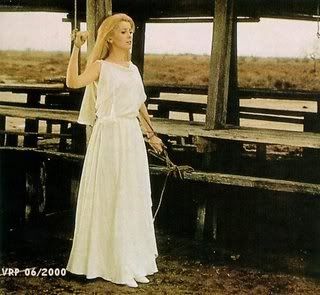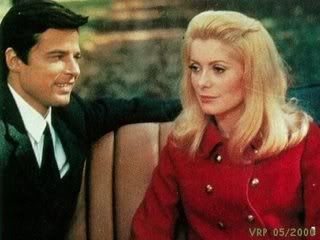Mad Men has been one of the most complex and detail-oriented drama TV shows in television for as far as I can remember, sparking a hot fashion moment, and its byzantine character delineation and intricacies of decor, dress and decorum has been admirably analyzed in more than one venue. Surely one more would be redundant? After all I already composed a piece on the fragrances worn by the characters and have mentioned tidbits again and again.
 |
| Peggy's motto in a nutshell, apparently. Pic via screeninvasion.com |
But deciding to re-watch the whole series, season to season, I stumbled upon a fragrance reference that really cracks the door open to a pivotal feminine character, Margaret "Peggy" Olson, in a light that has yet not been glimpsed.
If one fragrance has been mentioned categorically and early on on the show it was the classic amber oriental perfume Shalimar by Guerlain, as worn by office sex-bomb Joan Holloway, on her way out to town. This was in Season 1 Episode 10 "Long Weekend". Her roommate leans to ask, "Shalimar"? We can also see the characteristic acqua-shade bottles of the Guerlain Shalimar body products (deo spray?) on Joan's vanity throughout the show.
The choice clicked in a "perfect prop" sort of way in that it perfectly embodied the character of Joan; voluptuous and generous with an aspiring tinge (Joan can play the accordion while singing in French as we find out in Season 3).
 |
| still via bornunicorn.com who searches for products in films/TV and compiles an impressive compendium |
Image my surprise upon seeing another Mad Men character using Shalimar and not just the body products but the costly extrait de parfum...to go to work: innocent, prim little Peggy Olson! Nothing is as it seems indeed.
For the longest time I had trouble figuring out just what that mysterious dab-on bottle had been in Peggy's hand during the first episode of Season 2. It seemed like a pretty decadent use of perfume... dabbing behind ears and on wrists for a day in the office; unless one stops to recall that spray atomizers in a non pulverising manner were non existent back in the 1960s and that pulverising perfume containers risked putting on too much too easily.
Faintly I thought I could discern the fan-shaped blue cap of Shalimar. "No, that can't be" my inner little voice was saying. Lo and behold, in Season 3 Episode 2 ("Love among the ruins") there's Peggy singing Bye Bye Birdie in front of her mirror imitating Ann Margret, the episode's running theme. And right there on her right, we can clearly see this time an emptied little flacon of Guerlain's Shalimar. (This is around the 25th minute of the episode from those watching on DVD).
I guess we hadn't noticed before because we never looked for it.
Showing up twice in a show that has been as meticulous with its historical details and character descriptions as Mad Men couldn't be a coincidence. It had to mean something. Betty's fragrance tray in her Draper residence bedroom fittingly includes a pink-capped bottle of Coty's Muguet de Bois; a touch of the icy queen with her prim facade and her sexy undercurrent.
I was caught in a vortex of sought-for-clues for Peggy's fragrances. The game was afoot! What did Shalimar mean in this context?
Shalimar for a night out on the town in 1960 as worn by Joan Holloway would leave no one in any surprise. An established French perfume with a reputation, if a rather out there. Joan's professional decorum has never intervened with her femininity, even if the latter has on occasion intervened with the former. And her rich lovers (including Roger Sterling) could have been the generous gifters all right; after all that's how she got a fur coat in a flashback episode!
 |
| via telegraph.co.uk |
But Peggy Olson is far from the curvaceous sexpot that Joan is and never attracted the attention of rich lovers. In fact, back in the start of Season 2 when she dabs it on herself, she is still a budding junior copywriter, surely not making much with the 1960s wage gap. Cut as she is from a totally different cloth than either Joan or Betty, her sexuality seemed like it would be completely independent from her image. For that reason, and because as a woman it's far easier to sympathize and root for Peggy who tries to stick to her guns and earns her badge of professional status with her brains alone rather than exploiting her sex, the perfume community had long accepted that Peggy must have been wearing a chypre fragrance.
I have elsewhere elaborated on why chypre perfumes -sensual by design- have become code word for brainy and possibly -sexually speaking- haughty. The tsunami of increasing sweetness in perfumery has left classic compositions, which were sensuous and seductive to begin with, feeling like a bitch that needs her distance. A dominatrix at very best.
Boy, were we wrong.
Peggy Olson is far from a dominatrix but her sexual identity is far more complex than generally given credit for. Possibly because seen through a patriarchal lens she is deemed less "desirable" (or trophy-like) than either Joan or Betty (or Megan Draper or Jane Siegel...) and as women we have been guilty of often looking through that lens too. We had been definitely seeing Peggy through the eyes of the men around her.
Even in the pilot, when Peggy arrives at Sterling Cooper ad agency as the new secretary to Don Draper, she is exasperated by the overt sexism of the early 1960s office environment. She questions "why is it that everytime anyone asks you [girls] to lunch around here you're dessert". Office manager and guide Joan tells her to relax and take it within her stride: "You're the new girl. And you're not much to look at. So you might as well enjoy it."
For all her effectiveness Joan Holloway is still a woman impressed by patriarchy. Very much so.
Her self worth is still defined by how men view her. Betty Draper is too. ("As long as men look at me that way, I'm worth my keep", Betty intimates to her friend Francine)
Peggy nevertheless is different.
Despite her strict Catholic upbringing, she is no prude. In sexual matters she takes things into her own hands and asserts her sexual persona pretty directly and determinedly. She opts for contraception even though she has "no steady, just playing the field". She has a one-night-stand with a drunken Pete Campell who only a few hours ago offended her with his sexist comments. She determinedly gives her unwanted baby for adoption. She hangs out with the guys upon becoming a junior copywriter and even shows herself all dolled up in a strip joint if need be. Sure, she ends up sitting on the lap of the client, but we feel that she could have just as easily declined. We see her reject guys too. She challenges her colleague Stan Rizzo into nudism. She is in control. Later in the show she even jerks off a stranger at a public cinema!
To all this, there is nevertheless a fascinating angle that had been missing till this very discovery I just made. Peggy for all her strong-headed, autonomous thinking is consciously molding her sexual semiotics partly after Joan. She doesn't dress like her, of course, but in Love Among The Ruins there is a very crafty, and well crafted, analogy between the ad pitch that Don and the guys work on for Patio, a new diet drink by Pepsi, and the way Peggy views herself as a sexual being. Throughout the Patio project Peggy's point of missing the target audience (i.e. catering to men's ogling of the commercial's heroine rather than to women who would buy the product) is dismissed. There's a disparaging line from creative director Don telling her "he's sorry if it makes her uncomfortable". The scene is subtle, but we're led to believe it would be because she can't compete with the sexiness quota, that she's just jealous. When the Pepsi people shoot down the pitch, even though they were the ones to ask for the copy of the Bye Bye Birdie sequence in the first place, Peggy can't help smiling to herself.
It is in the same episode (S03E02) that we see her bottle of Shalimar, she actually copies a line of Joan's to make men interested in her when venturing out in a bar. Once there, she picks a young college guy, still socially awkward, and they go to his house for the night. In the lack of a Trojan, which she markedly demands amidst heavy petting, self-assured and very much a sexual being, Peggy suggests "we can do other things". In later seasons and later episodes we understand that this involves practices that back then were probably not deemed "sex per se". Again the patriarchal lens colors our definition of sex as only vaginal intercourse. But Peggy takes things to hand. Literally.
This "emulation" of a sexual persona in order to turn sexual expectations on their head takes further nuance with another memorable scene in Mad Men involving perfume and a sexpot. A different one.
It's in the Season 6 finale.
Peggy in a tiny black dress with a pink bow (and bright lipstick) is heading out for the evening. The office hasn't cleared yet.
-"Is that Chanel No.5?" , asks Frank Gleason smiling the air.
-"It's all I wear...", Peggy quips with a knowing smirk and leaves.
 |
| photo still AMC via NYMag.com |
The brilliant line directly reflects Marilyn Monroe's memorable one regarding her exclusive use of Chanel No.5 in bed. Not only does Peggy's line then assert her status as a classy customer of Chanel's (remember, the French house is mentioned in the pilot as the epitome of class), but it stresses her emulation of a sexually uninhibited and desirable woman. Contrary to Marilyn though, Peggy can have her cake and eat it too.
One might think that a sex symbol like Marilyn would hardly be a model for a woman of the determination and proto-feminism that Peggy exhibits. But the brilliance of the show and the depth of the characters is the interweaving of lines and ideas throughout the seasons. Back in Season 2 Episode 6 ("Maidenform") an imaginative bra pitch involving "two sides of a woman" implied that every woman is either a Jackie [Kennedy] or a Marilyn [Monroe]. " A line and a curve". Peggy is doubtful; and left out by the guys who see her as neither. Copywriter Paul Kinsley presented showing women working the floor at Sterling Cooper as either one or the other archetype. "Marilyn...[he says, pointing Joan to the other guys] Of course Marilyn is really a Joan, not the other way around."
And suddenly it all makes sense.
We are also reminded of the advice of another emancipated and sexually liberal woman to Peggy. That of Bobbie Barrett, the sex interest of Don Draper during Season 2: "Don't be a man. Be a woman. It's powerful business when done right."
So... Guerlain's Shalimar and Chanel No.5. A full on "oriental" perfume and an aldehydic floral fragrance. Not at all what we expected of Peggy. The fragrant moments of Peggy Olson's evolution arc in Mad Men prove that the semiotics of perfume are both powerful and evocative of women's issues throughout the 20th century and beyond.
.jpg)








